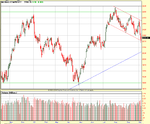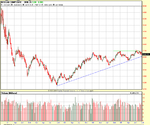timsk
Legendary member
- Messages
- 8,830
- Likes
- 3,533
dbphoenix said:Those who are interested in the interpretation of price movement, the relationship of price and "volume" (i.e., trading activity, not inventory), and how all of this interacts with support and resistance would have a tough time finding a better example than the movement of the major U.S. indices over the past two-three months, particularly yesterday.
--Db
Good to see you posting again db - you've been very quiet of late!
Weekly and Daily chart of the Naz Comp attached.
The horizontal green lines denote zones of S/R, the bloo line is the long term trend. The red channel is included as traders the world over will have spotted this and applied convention T.A. criteria and concluded that it's a big juicy bull flag. Conventional wisdom dictates that price will retrace to the long term trend line and then shoot northwards with greater speed and velocity than Aston Martin's new Vantage. However, readers of this thread will have a watchful eye on volume which, broadly speaking, has tended to rise when the index has moved up and dropped off when the index has fallen. Up until this week that is, when the volume accompanying Tues, Weds, and Thurs bear candles was high. To my mind, this brings into question contrakt's assertion that "probabilities favour moves to the upside".
Tim.
Attachments
Last edited:












